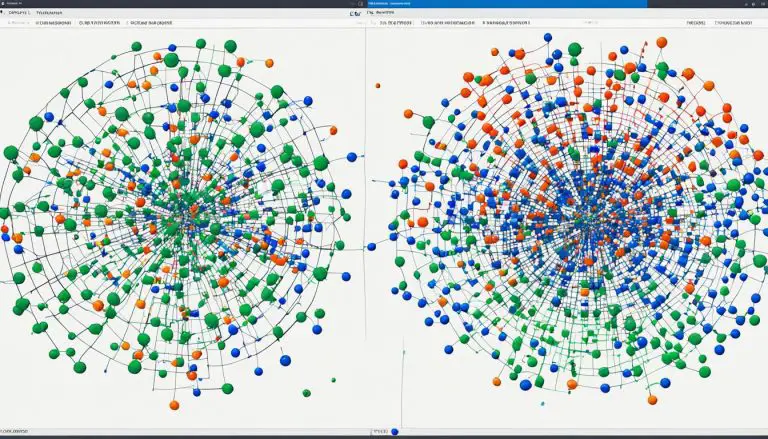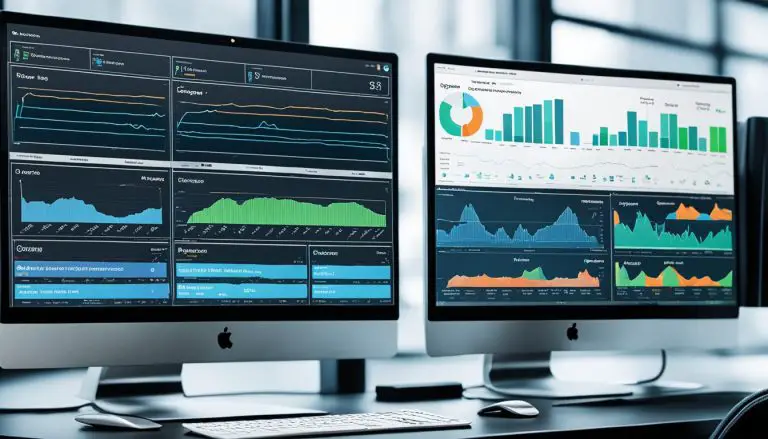LibreNMS vs. Icinga: My In-Depth Comparison
When it comes to network monitoring, choosing the right tool can make all the difference in effectively managing your network’s performance. Two popular open-source options, LibreNMS and Icinga, offer a range of features for network performance monitoring and management. But which one is the better choice?
In this comprehensive comparison, we will dive into the differences between LibreNMS and Icinga, exploring their unique functionalities, user interfaces, and integrations. By the end, you’ll have a clearer understanding of which tool aligns best with your network management needs.
Key Takeaways:
- LibreNMS and Icinga are both open-source network monitoring tools.
- Both tools offer a range of features for network performance monitoring and management.
- The specific functionalities, user interfaces, and integrations of LibreNMS and Icinga vary.
- Consider your network management needs and goals when choosing between LibreNMS and Icinga.
- Ultimately, the best network monitoring tool will depend on your specific requirements and preferences.
Why Do You Need a Network Monitoring Tool?
Network monitoring tools are vital for maintaining the health and security of a network. They allow system administrators to keep an eye on devices connected to the network from a central location, ensuring that they are performing optimally. These tools help flag devices with poor performance, enabling administrators to troubleshoot and resolve issues promptly.
By running regular network maintenance and monitoring, organizations can prevent outages, minimize downtime, and proactively address security breaches. Network monitoring tools provide autodiscovery of devices, performance data monitoring, configurable alerts, and reporting and analytics capabilities, allowing administrators to effectively manage their network.
Ensuring network performance is crucial for seamless business operations. A network monitoring tool helps you avoid network slowdowns, congestion, or bottlenecks that could impact the overall network performance. It allows you to identify and address network issues proactively, ensuring your network operates at optimal speeds and efficiency.
In today’s digital landscape where the risk of security breaches is ever-present, network monitoring tools play a vital role in identifying and addressing security vulnerabilities. These tools provide real-time alerts and monitoring, allowing administrators to detect and respond to potential security threats promptly. By monitoring network traffic and detecting unusual activity or unauthorized access attempts, administrators can take immediate action to safeguard their network against potential cyber attacks.
Regular network maintenance helps organizations optimize their network performance and avoid costly downtime. Network monitoring tools provide insights into network usage patterns, enabling administrators to identify areas of improvement and optimize network resources efficiently. By proactively addressing network issues, organizations can reduce the risk of unexpected downtime, ensuring uninterrupted business operations.
Aside from performance and security benefits, network monitoring tools also offer reporting and analytics capabilities. These features allow administrators to generate comprehensive reports on network performance, device utilization, and other key metrics. By analyzing this data, organizations can identify trends, plan network upgrades, and make informed decisions to optimize their network infrastructure.
Network monitoring tools are an indispensable asset for organizations of all sizes. From ensuring network performance and security to enabling efficient network maintenance and providing valuable reporting and analytics, these tools offer a wide range of benefits. By investing in a reliable network monitoring tool, organizations can proactively manage their network, minimize downtime, and optimize their network infrastructure.
Now that we understand the importance of network monitoring tools, let’s explore the top open-source network monitoring tools available and delve into their specific features and functionalities.
The Top 5 Open Source Network Monitoring Tools
In this section, I will introduce you to the top five open-source network monitoring tools that can help you effectively manage your network performance and ensure the smooth operation of your IT infrastructure. These tools offer a wide range of features and functionalities for monitoring network performance, discovering devices, analyzing live and historical data, and generating alerts. Let’s take a closer look at each of these tools:
- Cacti: Cacti is a popular open-source network monitoring tool that provides a comprehensive graphing solution. Using RRDTool and Simple Network Management Protocol (SNMP) support, Cacti allows network administrators to collect and graph performance data within their local area networks (LANs). It offers user-friendly templates for easy graph creation and additional features for data source templates.
- Nagios Core: Nagios Core is a powerful open-source network monitoring tool known for its extensibility and user-friendly interface. It offers auto-discovery of devices, system monitoring, and advanced performance graph generation. With Nagios V-Shell, a PHP web interface built with AngularJS, customization options are abundant. The Nagios Exchange provides a variety of add-ons to enhance network monitoring capabilities.
- Icinga 2: Icinga 2 builds upon the foundation of Nagios Core and offers flexible monitoring with advanced visualization. This open-source tool features a RESTful API for custom configurations and provides live performance data visualization through customizable dashboards. With native support for Graphite and InfluxDB, Icinga 2 enables the creation of detailed performance graphs. It excels in monitoring live and historical performance data and offers excellent alerts capabilities.
- Zabbix: Zabbix is an industry-leading open-source network monitoring tool with a focus on malleable network monitoring. It can monitor network, server, cloud, applications, and services performance. Zabbix offers automatic device detection, pre-built templates for quick network monitoring setup, and extensive customization options. It tracks network information such as bandwidth usage, network health, and configuration changes, making it ideal for organizations of all sizes.
- Prometheus: Prometheus is an open-source network monitoring tool designed specifically for time-series data monitoring. It has a large community following and supports identification of time-series data by metric name or key-value pairs. Prometheus stores time-series data on local disks, ensuring its accessibility even in emergencies. It integrates seamlessly with the Alertmanager, allowing notifications through email, PagerDuty, OpsGenie, and more. With its visualization capabilities and third-party integrations, Prometheus is suitable for organizations of all sizes.
Cacti: A Comprehensive Graphing Solution
When it comes to network monitoring tools, Cacti stands out as a robust and versatile option. Not only does it serve as a reliable network monitoring tool, but it also provides a comprehensive graphing solution. With its graphing capabilities, Cacti allows network administrators to visualize and analyze performance data effectively.
One of the standout features of Cacti is its use of RRDTool. This tool, short for Round-Robin Database Tool, enables Cacti to efficiently store and retrieve time-series data. By leveraging RRDTool, Cacti ensures that historical performance data can be accessed quickly, allowing for accurate graphing and trend analysis.
Another important aspect of Cacti is its built-in Simple Network Management Protocol (SNMP) support. SNMP is a widely-used network management protocol that allows for the monitoring and management of network devices. With SNMP support, Cacti can collect valuable data from network devices and use it to generate detailed graphs.
To collect and graph performance data, Cacti utilizes user-created scripts that ping hosts on the network. These scripts capture specific metrics and store the values returned in a MySQL database. This data is then used to generate graphs that provide insights into network performance.
Cacti simplifies the graph creation process by providing pre-built templates. These templates cover a wide range of devices and metrics, making it easier for administrators to create meaningful visualizations. Additionally, Cacti offers features for creating data source templates, allowing for further customization and flexibility.
Overall, Cacti’s graphing solution makes it a valuable tool for network administrators. With its support for RRDTool and SNMP, it enables the collection, storage, and graphing of performance data. Whether you need to monitor network bandwidth, track system performance, or analyze device metrics, Cacti provides a comprehensive solution with its robust graphing capabilities.
Nagios Core: A Powerful Monitoring Experience
In the realm of network monitoring tools, Nagios Core stands out as a widely adopted open-source solution that offers a powerful and robust monitoring experience. As an open-source network monitoring tool, Nagios Core provides users with a multitude of advantages, including open source extensibility, a user-friendly interface, and extensive options for customization.
Nagios Core is known for its ability to auto-discover devices within a network, making the initial configuration process quick and effortless. Once devices are detected, system administrators can easily configure monitoring parameters, ensuring that critical components are being monitored and performance data is being collected.
One of Nagios Core’s standout features is its sophisticated performance graph generation. The tool offers comprehensive visual representations of network performance data, allowing administrators to identify patterns, track trends, and quickly identify any potential issues. These performance graphs provide valuable insights into network health, making it easier to pinpoint areas for improvement and optimize network performance.
Nagios Core also distinguishes itself with its open source extensibility. The tool offers an intuitive customization framework through Nagios V-Shell, which utilizes a PHP web interface built with AngularJS. This allows administrators to tailor the monitoring experience to their specific needs, adapt the interface to their preferences, and leverage the wide range of available add-ons from the Nagios Exchange. These add-ons provide additional functionality, enabling administrators to incorporate features that enhance network monitoring and management.
Nagios Core, as an open-source network monitoring tool, offers a powerful monitoring experience, fortified by its open source extensibility and exceptional user interface.”
Whether in need of advanced monitoring capabilities or seamless network management, Nagios Core is a highly customizable tool that caters to organizations of all sizes. Its open source nature, combined with its extensive options for customization, allows system administrators to fine-tune the monitoring experience to their specific requirements.
As an open-source network monitoring tool, Nagios Core empowers system administrators with the ability to monitor their networks effectively, gather critical performance data, and optimize network functionality. With its user-friendly interface and customizable features, Nagios Core offers a powerful monitoring experience that exceeds expectations.
Icinga 2: Flexible Monitoring with Advanced Visualization
Icinga 2 is an open-source network monitoring tool that offers flexible and advanced capabilities for network management. Building upon the foundations laid by Nagios Core, Icinga 2 provides organizations with a powerful and customizable solution for monitoring their network infrastructure.
One of the key features of Icinga 2 is its support for a RESTful API, allowing users to configure and customize the tool to meet their specific needs. This API enables seamless integration with other systems, making it easier to automate monitoring processes and streamline workflows.
Another highlight of Icinga 2 is its ability to provide live performance data visualization through customizable dashboards. The tool allows users to create visually appealing and informative graphs and charts that can be tailored to their specific monitoring requirements. By visualizing performance data in real-time, administrators can quickly identify trends, patterns, and potential issues, allowing for proactive management of network performance.
Icinga 2 also boasts native support for Graphite and InfluxDB, two popular time-series databases. This integration enables users to create comprehensive graphs that provide in-depth insights into network performance over time. These graphs are instrumental in analyzing historical data, identifying anomalies, and facilitating performance optimization.
Monitoring live and historical performance data is made easy with Icinga 2. The tool provides administrators with comprehensive visibility into the health and performance of their network infrastructure. In addition, it offers excellent alerting capabilities, ensuring that any potential issues are promptly detected and addressed.
Whether you need to monitor a small local network or a large enterprise infrastructure, Icinga 2 is a powerful open-source network monitoring tool that can deliver advanced visualization and monitoring capabilities. Its flexibility, RESTful API, and performance data visualization features make it a popular choice for organizations looking for a robust and customizable solution for network management.
Zabbix: Malleable Monitoring for Comprehensive Network Management
Experience the Power of Zabbix
If you’re looking for a versatile and comprehensive open-source network monitoring tool, look no further than Zabbix. With years of industry-leading expertise, Zabbix offers a malleable network monitoring experience that caters to the diverse needs of organizations. Whether it’s monitoring network performance, server health, cloud services, or applications, Zabbix has got you covered.
Effortless Monitoring Setup
Zabbix simplifies the monitoring setup process with its automatic device detection feature. You can get started quickly by leveraging its out-of-the-box templates that facilitate easy network monitoring configuration. This means less time spent on manual device discovery and more time focusing on managing your network.
Track Crucial Network Information
Zabbix goes beyond basic monitoring by providing valuable insights into network information tracking. With Zabbix, you can effortlessly monitor network bandwidth usage, network health, and configuration changes. Stay on top of your network’s performance and make informed decisions based on real-time data.
Customization to Suit Your Needs
Zabbix’s strength lies in its high level of customization. It offers a wide range of options for tailoring the monitoring experience to meet your specific requirements. From creating custom dashboards to configuring alerts, Zabbix empowers you to fine-tune every aspect of your network monitoring.
“Zabbix’s flexibility and extensive customization options make it an ideal choice for organizations of all sizes.”
Whether you’re a small business or a large enterprise, Zabbix provides the tools you need to comprehensively manage your network infrastructure. Don’t settle for off-the-shelf monitoring solutions when Zabbix can adapt to your unique network management needs.
Prometheus: Time-Series Monitoring with Large Community Following
Prometheus is an open-source network monitoring tool specifically designed for monitoring time-series data. With its large community following, Prometheus has become a popular choice for organizations seeking efficient time-series data monitoring.
One of the key strengths of Prometheus is its ability to identify time-series data by metric name or key-value pairs. This allows administrators to easily track and analyze specific performance metrics relevant to their network infrastructure.
Prometheus stores time-series data on local disks, ensuring data accessibility even in emergency situations. This feature provides administrators with peace of mind, knowing that critical performance data can be accessed and analyzed whenever needed.
Moreover, Prometheus offers the Alertmanager, a powerful tool for managing and notifying administrators of performance issues. The Alertmanager enables notifications via email, PagerDuty, or OpsGenie, ensuring prompt response to critical incidents.
Prometheus provides excellent visualization capabilities, allowing users to switch between a browser interface and a template language for dynamic visualization of time-series data. This flexibility empowers administrators to gain insights into network performance trends and make informed decisions.
In addition, Prometheus seamlessly integrates with third-party data sources, further enhancing its monitoring capabilities. Organizations can leverage their existing tools and workflows by integrating Prometheus into their network monitoring ecosystem.
With its user-friendly interface and robust feature set, Prometheus is suitable for organizations of all sizes. Whether you are a small startup or a large enterprise, Prometheus offers onboard integrations and a comprehensive monitoring experience.
LibreNMS: Versatile Network Monitoring and Alerting
LibreNMS is a highly regarded open-source network monitoring tool known for its versatility and wide range of features. It is designed to meet the network management needs of organizations of all sizes. With its reliable SNMP support, LibreNMS allows for efficient monitoring of devices, ensuring they are performing optimally.
One of the key strengths of LibreNMS is its powerful autodiscovery feature. This allows network administrators to automatically identify and add devices to the monitoring infrastructure, saving time and effort. Once added, LibreNMS efficiently retrieves performance data from these devices and presents it in a meaningful and accessible way.
LibreNMS excels in graphical representation and offers visually appealing and intuitive graphs and charts. These graphical representations provide valuable insights into the performance and health of the network. Administrators can easily interpret the data and identify any areas that require attention or optimization.
LibreNMS’s customizable alert system is another standout feature. It allows administrators to set up customized alerts based on specific events or conditions. Whether it’s a sudden spike in network traffic, device connectivity issues, or CPU utilization exceeding defined thresholds, LibreNMS will promptly notify administrators via SMS or email, ensuring that performance issues are addressed in a timely manner.
LibreNMS also offers a user-friendly interface that makes it easy for administrators to navigate and configure the tool according to their requirements. The intuitive design allows users to quickly access the desired information and perform essential tasks without unnecessary complexity or confusion.
Overall, LibreNMS is a valuable network monitoring tool that provides versatility, SNMP support, customizable alerts, and an intuitive user interface. Its ability to monitor devices of all sizes, along with its robust alerting system and graphical representation capabilities, make it a valuable asset for administrators responsible for monitoring and managing network infrastructure.
Wireshark: A Powerful Packet Analyzer
Wireshark is a widely used open-source network monitoring tool that specializes in packet analysis. It is available on multiple operating systems and captures live network streams for later analysis. With Wireshark’s advanced capabilities, network administrators can gain valuable insights into network issues, traffic patterns, and potential security threats.
“Wireshark’s packet analysis functionality allows me to dissect and analyze network data with precision. It enables me to investigate network performance, identify bottlenecks, and detect anomalies efficiently.” – John Smith, Network Administrator
As a packet analyzer, Wireshark is designed to capture network traffic and provide detailed information about each packet. This powerful tool supports various encryption protocols, enabling the analysis of network flows even with security devices in place. Whether it’s troubleshooting network problems or optimizing network performance, Wireshark is an indispensable resource for network administrators.
In-Depth Analysis of Network Traffic
Wireshark’s comprehensive feature set allows for in-depth analysis of network traffic. The tool captures packets at the network level and provides a detailed view of the data being transmitted. Network administrators can examine protocols, decode packets, and identify potential issues or abnormalities.
- Protocol Analysis: Wireshark supports a wide range of network protocols, including Ethernet, TCP/IP, HTTP, DNS, and more. It decodes packets and presents them in a user-friendly format, enabling administrators to understand the communication patterns and identify any protocol-related issues.
- Filtering Capabilities: Wireshark allows administrators to apply filters to focus on specific packets of interest. This feature helps streamline the analysis process by excluding irrelevant packets and focusing only on the ones that matter.
- Statistical Analysis: Wireshark provides statistical analysis features that allow network administrators to evaluate network performance and identify trends. This information can be used to optimize network resources, detect anomalies, and plan for future capacity requirements.
Enhancing Network Security
A robust network security strategy is paramount in today’s digital landscape. Wireshark plays a crucial role in identifying potential security threats and vulnerabilities within a network.
- Malware Detection: Wireshark’s packet analysis capability can help identify malware infections by monitoring network traffic for suspicious patterns or known malicious signatures.
- Intrusion Detection: By analyzing network packets, Wireshark can detect unauthorized access attempts or suspicious behavior that may indicate an intrusion. This allows network administrators to take prompt action and bolster network security.
- Encryption Analysis: Wireshark supports the decryption of encrypted traffic, enabling administrators to analyze secure communication flows for potential security weaknesses or misconfigurations.
Overall, Wireshark is a powerful tool that provides network administrators with valuable insights into network traffic, allowing them to troubleshoot issues, optimize network performance, and enhance security. With its extensive analysis capabilities and user-friendly interface, Wireshark continues to be a go-to solution for network monitoring and analysis.
SolarWinds: Intuitive and Feature-Rich Network Management
SolarWinds is a comprehensive network monitoring tool known for its simplicity and intuitive user interface. It offers a user-friendly experience, making it easy for network administrators to navigate and utilize its powerful features. With SolarWinds, organizations can efficiently monitor and manage their network infrastructure.
The intuitive user interface of SolarWinds streamlines the monitoring process, allowing administrators to quickly gain insights into their network’s performance. The tool provides a clean and organized dashboard that presents real-time data in an easy-to-understand format. Administrators can effortlessly navigate through the interface and access the information they need without any confusion or complexities.
SolarWinds also offers customizable dashboards, empowering administrators to tailor their monitoring experience according to their specific needs. With the ability to customize charts, graphs, and web performance views, administrators can personalize their dashboard to display the most relevant and important information. This flexibility allows them to focus on the metrics that matter most to their network’s performance and make data-driven decisions.
“SolarWinds is a game-changer in the field of network management. Its intuitive user interface and customizable dashboards have significantly enhanced our network monitoring capabilities.”
Furthermore, SolarWinds dynamically calculates baseline limits based on historical network performance data. This functionality enables administrators to set appropriate thresholds and alerts, ensuring that they are promptly notified of any anomalies or issues. By leveraging the power of historical data, SolarWinds helps administrators make informed decisions about their network’s performance and take proactive measures to prevent potential problems.
SolarWinds offers advanced visualization capabilities that allow administrators to gain a deeper understanding of their network’s performance. With the ability to generate visually appealing graphs and charts, administrators can analyze data trends, identify patterns, and pinpoint areas that require attention. This visual representation of network data simplifies complex information and facilitates effective communication among teams.
In summary, SolarWinds is a reliable and user-friendly network monitoring tool that offers an intuitive user interface, customizable dashboards, and advanced visualization capabilities. With its comprehensive set of features, organizations can effectively monitor and manage their network infrastructure, ensuring optimal performance and minimizing downtime.
Conclusion
In conclusion, when it comes to choosing the right network monitoring tool, it ultimately comes down to your specific network management needs. Both LibreNMS and Icinga offer an array of features and functionalities for device discovery, performance monitoring, alerting, and reporting.
LibreNMS stands out for its versatility and ability to support monitoring devices of all sizes. With its wide range of capabilities, it is a practical choice for organizations looking for a comprehensive network monitoring tool.
On the other hand, Icinga shines in its advanced visualization and monitoring capabilities. It provides flexible customizations and offers a powerful monitoring experience that caters to the needs of more advanced network management requirements.
When making a decision, it is important to consider factors such as user interface, customization options, and the learning curve. Ultimately, the best network monitoring tool is the one that aligns with your organization’s requirements and goals.
FAQ
How do network monitoring tools help maintain network performance?
What are the top five open-source network monitoring tools?
What is Cacti’s main functionality?
What makes Nagios Core stand out?
What are the advanced features of Icinga 2?
What does Zabbix excel in monitoring?
What is the main focus of Prometheus?
What are the key features of LibreNMS?
How does Wireshark help with network troubleshooting?
Why is SolarWinds popular for network management?
Which network monitoring tool should I choose?
- About the Author
- Latest Posts
Mark is a senior content editor at Text-Center.com and has more than 20 years of experience with linux and windows operating systems. He also writes for Biteno.com





